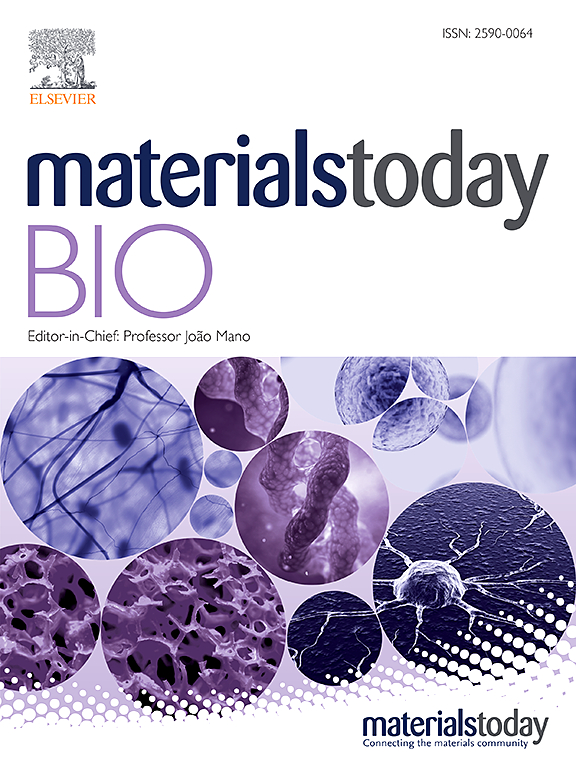fe掺杂MOF纳米颗粒:LIFR和BMP4双信号通路激活调节剂对小鼠胚胎干细胞体外扩增的影响
IF 8.7
1区 医学
Q1 ENGINEERING, BIOMEDICAL
引用次数: 0
摘要
在小鼠胚胎干细胞(mESCs)的培养中,通常使用白血病抑制因子(LIF)和有丝分裂失活的小鼠胚胎成纤维细胞(MEFs)来维持mESCs的自我更新和多能性。然而,LIF的高成本和mef的免疫原性限制了其在mESCs稳定培养和大规模扩增中的临床应用。因此,有必要寻求一种低成本、方便、安全的替代方案。本研究发现,Fe掺杂金属有机骨架纳米颗粒(Fe MOF)在长期培养下具有良好的生物相容性,能够在缺乏LIF和mef的情况下维持mESCs的自我更新,而不会破坏mESCs向三种生殖层细胞分化的潜力。通过转录组测序,证明Fe MOF纳米材料不仅可以上调LIFR/GP130的表达,更重要的是,它们可以激活Fe3+介导的BMP4/ALK/SMAD信号通路。实验结果表明,Fe MOF纳米材料能够有效地维持mESCs的自我更新和多能性。本研究表明,Fe MOF不仅可以替代LIF因子,而且由于其多信号通路调控功能,具有更强的促进mESCs自我更新的能力,在mESCs体外培养中具有应用前景。本文章由计算机程序翻译,如有差异,请以英文原文为准。

Fe-doped MOF nanoparticles: the LIFR and BMP4 dual-signaling pathways activated regulator for in vitro expansion of mouse embryonic stem cells
In the cultivation of mouse embryonic stem cells (mESCs), leukemia inhibitory factor (LIF) and mitotically inactive mouse embryonic fibroblasts (MEFs) are usually used to maintain the self-renewal and pluripotency of mESCs. However, the high cost of LIF and the immunogenicity of MEFs limit their clinical application in stable culture and large-scale expansion of mESCs. Therefore, it is necessary to pursue a low-cost, convenient, and safe alternative. This study found that Fe-doped metal organic framework nanoparticles (Fe MOF) have good biocompatibility under long-term cultivation and could maintain the self-renewal of mESCs in the absence of LIF and MEFs, without destroying the potential of mESCs to differentiate into three germ layer cells. Through transcriptome sequencing, it was demonstrated that Fe MOF nanomaterials could not only upregulate the expression of LIFR/GP130, but more importantly, they could activate the Fe3+ mediated BMP4/ALK/SMAD signaling pathway. The experimental results indicate that Fe MOF nanomaterials could effectively maintain the self-renewal and pluripotency of mESCs. This study demonstrates that Fe MOF could not only replace the LIF factor, but also has a stronger ability to promote the self-renewal of mESCs owe to its multi-signal pathway regulation function, providing application prospects in the in vitro cultivation of mESCs.
求助全文
通过发布文献求助,成功后即可免费获取论文全文。
去求助
来源期刊

Materials Today Bio
Multiple-
CiteScore
8.30
自引率
4.90%
发文量
303
审稿时长
30 days
期刊介绍:
Materials Today Bio is a multidisciplinary journal that specializes in the intersection between biology and materials science, chemistry, physics, engineering, and medicine. It covers various aspects such as the design and assembly of new structures, their interaction with biological systems, functionalization, bioimaging, therapies, and diagnostics in healthcare. The journal aims to showcase the most significant advancements and discoveries in this field. As part of the Materials Today family, Materials Today Bio provides rigorous peer review, quick decision-making, and high visibility for authors. It is indexed in Scopus, PubMed Central, Emerging Sources, Citation Index (ESCI), and Directory of Open Access Journals (DOAJ).
 求助内容:
求助内容: 应助结果提醒方式:
应助结果提醒方式:


